After mostly exploring more of downtown Cape Town yesterday, today we looked forward to a drive south of the city to the Cape of Good Hope, located only 60 miles away. Since we had already visited some of the beaches on the Cape's Atlantic Ocean side, driving down on the Indian Ocean side of the Cape would be a wonderful change.
It's hard not to be effusive when talking about the drive as it was just fantastic following the coast all the way. In addition, we often passed trains hugging the coast to and from Cape Town on the way down to Simon's Town, the southernmost train station in Africa. Simon's Town was earmarked as a safe winter harbor in 1687 and then received that official proclamation in 1741. Not surprisingly given its early history, the town is home to the country's navy.
We had seen a number of Beware of Baboon signs all along the road/highway south of Cape Town. We knew to exercise extra caution when near them because they couldn't be not played with, touched or fed as they can be aggressive.
We arrived at the Cape of Good Hope entrance by 9ish as we had known to make sure to arrive early to beat the crowds. Some tourists had reported waiting in a traffic jam outside the entry gates for over an hour, because they arrived around 11 am. The area was declared a nature reserve in 1938 and became part of the Cape Peninsula National Park in 1998.
A few years later, the park's name changed yet again, this time to Table Mountain National Park which contains two well-known landmarks: Table Mountain in Cape Town, for which the park is named and the Cape of Good Hope, the most southwestern most extremity of Africa. The latter property is included as part of the UNESCO Cape Floral Region World Heritage Site.
Shortly after entering the park, the terrain changed markedly. It became very rocky with a profusion of spectacular flowers and multi-colored low lying bushes.
It wasn't surprising that, since the southern part of Table Mountain National Park near the Cape of Good Hope is constantly exposed to gale-force winds, the vegetation was limited to hardy milk wood trees and scrub.
From a distance, these bushes looked like white rocks dotting the landscape as there were so many of them. I learned that all the flowers and the small belt of natural shrub land we were seeing were fynbos, meaning fine-leaved plants. Fynbos grows in a coastal belt stretching from the west coast to the southeast coast of South Africa. South African fynbos largely makes up the tiniest floral kingdom in the world.
We were extremely fortunate seeing so many of the Cape Snow bush flowering because they only bloom from November until January.
The country's fynbos makes up 80% of the Cape Floral Region, a world of finely branched plants exquisitely adapted to flourish in poor soils and wildly varying rainfall. "In this small area, equivalent to a thinly smeared Portugal, there are more than 9,000 plant species, and of those, 70% are endemic." I thought it amazing that a full 3% of all the world's plants are found here, on less than 0.05% of the earth's land surface!
South African fynbos vegetation includes proteas, ericas and restios or reeds. This flower kingdom is the origin of some of the world's favorite plants: gladioli, freesias, nerines, agapanthus and ixia and, of course, beloved geraniums and pelargoniums.
These gorgeous yellow bushes, known by their Dutch name, as Kreupelhout or English name as pincushions, bloom from August until January.
This beautiful old homestead with a thatched roof near the Visitors Center was known as Skaife's Barn. The building was a tribute to Sydney Harold Skaife, an entomologist whose enthusiasm contributed to the establishment of the Cape Town Nature Reserve.
These Everlasting flowers, which belong to the Aster family, bloom from November until February in the Cape Floral Region.
Our drive continued slowly south toward the Cape as we took in the fabulous views still of the Indian Ocean.
From the Cape Point parking lot, we hiked to the lighthouse, barely visible in the background. On the lower left of the photo is the sign that reminded us of how dangerous baboons could be, especially if there were food around.
I persuaded myself I was so far behind Steven because I had been busy taking flower pictures, not because I needed a breather!
The walk up to the viewing platform and the old lighthouse was very steep but worth every step once we were privy to such stunning views. It took six years, from 1913 to 1919, to build the old lighthouse, 816 feet above the high-water mark. The lighthouse stood guard over one of the most strategic sea lanes in the world.
We were lucky that there were few winds at the top because at times they are reputed to be extremely fierce. I always think these directional markers are fun; we were 'only' 12,541 kms or about 7,800 miles from New York!
Someone else wrote very poetically that "Cape Point is a dramatic knife's edge of rock that slices into the Atlantic." Looking out to sea from the viewing platform, we felt like we were at the tip of Africa, even though that honor officially belonged to another dramatic point at Cape Agulhas, about 100 miles to the southeast.
Dias called the Cape Cabo das Tormentas or "Cape of Storms" which was the original name of the Cape of Good Hope. It was given its more optimistic title by King John of Portugal who saw it as a positive omen for a new route to India.
Peekaboo - I love you!
When we looked out across the water, it was hard to imagine that the next land fall is Antarctica! I wonder if Steven and I will ever reach that continent.
I read that the park has some excellent land-based whale watching spots from about June to November when whales return to these waters to calve. We were too late for them, though.
Seeing the waves pounding the shore unrelentingly was just out of this world.
Later, we drove on the Indian Ocean side of the Cape to the first of two replicas, the da Gama Cross, of navigational beacons erected by the Portuguese government. It, and its companion, the Dias Cross located on the Atlantic Ocean side, commemorated Vasco da Gama and Bartolomeu Dias, the first explorers, in 1497 and 1507 respectively, to reach the Cape. While at the Vasco da Gama beacon, I learned a new word 'padrao,' which meant a limestone memorial with the Portuguese coat of arms and an inscription stating when and by whom it was raised. The cross symbolized Portuguese sovereignty and Christianity.
The Dias and da Gama crosses weren't however original padraos. How the originals were built, what they looked like and where they were is a matter that has never been resolved. Both structures, built in 1965, were monuments to da Gama and Dias and serve as beacons helping ships avoid the nearby dangerous Whittle Rock.
Since the tip of the Cape was so narrow, it was pretty easy to crisscross from one side to the other on the park's many roads. Not far away from the da Gama cross was the imposing Dias beacon or cross which overlooked the Atlantic Ocean. Unlike the da Gama beacon, it was painted black on the seaward side so that it was silhouetted against the sky for navigators.
That wasn't as easy as it might sound because it entailed my hiking through a lot of the fynbos to be able to view its black side. I had fun though traipsing through the brush!
We continued to be enthralled by the most amazing views of the South African coastline as we headed north on the Indian Ocean side of the park, back toward the main entrance gate.
This stretch of coastline was rather ominously called Black Rocks.
The terrain, that had been so lush just a few miles back, soon differed significantly.
It was so hard to tell whether these trees, which I am pretty sure were called milk wood trees, were alive or dead! If indeed they were milk woods, they are a Southern African coastal tree, with dense foliage, black berries and small, stinky, greenish flowers.
It was so easy to imagine the overwhelming power of the Cape winds battering the trees' branches to and fro.
Another gorgeous (to me at least!) view of fynbos as we left the park about 1:30 heading north toward Simon's Town again so we could stop at nearby Boulders Beach.
This has got to be one of the most unusual road signs surely you've ever seen, right? Well, if not for you, it sure was for us?
We caught sight of a number of small coves with white sandy beaches and calm shallow water interspersed between boulders of Cape granite.
There is no record of the birds having lived here prior to the mid 1980s, so their decision to settle so close to a residential area was remarkable. There are only two other penguin populations on the mainland in southern Africa.
The newly constructed boardwalks at Foxy Beach made all the difference in our being able to have superb views of the penguins.
It was positively captivating viewing them from the boardwalk as we could observe them from very close range as they wandered freely in a protected, natural environment.
Think I could have gone without gazing at these poop-covered boulders, though!
We didn't know in advance that December was the peak time that so many juvenile birds molted on the beach. What a lucky break once again for us being able to witness that happening!
During the molting season, old worn feathers are replaced. Because the birds lose their waterproofing, the penguins are confined to land for about 21 days. African penguins 'fatten up' before the molt, which is a period of starvation.
The penguins' distinctive black and white coloring is a vital form of camouflage: white for underwater predators looking upwards and black for predators looking down into the water.
Two more ventured into the shallow water before quickly turning around!
Once we had found empty spots by the railing. I never wanted to leave. Steven had to practically tear me away as I was so entranced watching those cute penguins! Lil Red: I know you would have so loved being right there too even though you and Pat have been fortunate enough to also see penguins during your trip to Antarctica.
It was definitely our pleasure making our acquaintance of penguins in Boulders!
Literally just across the road from the shantytown was this gorgeous and beautifully tended farm.
A case of the haves and have nots, living so close together and yet, so far apart.
Another baboon sign but none luckily on the highway.
Once again, the beauty of the drive and the scenery was just mind boggling as we approached Misty Cliffs, a conservation village.
Though the rock formation was called Camel Rock, I found it hard to determine how it had gotten its name!
The beaches had some of the whitest sand imaginable. Too bad it was getting rather late in the day for us to curl our toes in the sand and walk for miles along the many beaches!
Mini sand dunes were common along this part of the highway.
The drive down to the lighthouse was so delightful.
Since 1500, more than 2,000 ships have been wrecked along the coast of South Africa and yet it took years of negotiation to raise awareness and funding before many of these beacons of light were built. Lighthouses were often located in remote, inhospitable places that made them difficult to install and maintain as well as lonely for lighthouse keepers.
I found this pretty shell in the lighthouse parking lot; it got home safe and sound and is now on our kitchen counter keeping company with so many other shells we found this trip. All the others, though, did come from the sea and not parking lots!
From Kommetjie, the Cape veered pretty sharply inland as we followed the Chapman's Peak Drive northward, a toll road and famous for being one of the most breathtaking drives in the world.
The 5.5 mile long Chapman's Peak Drive has 114 curves and skirts the coast halfway up the sheer cliffs of Chapman's Peak.
Construction of the road, which started in 1915 and took seven years to complete, first opened to traffic on May 6th, 1922. It was closed in 2000 due to rock falls and was extensively modified to make it a safe toll road. In most places, the speed limit was only 12 mph.
However, there were still constant signs admonishing us to use the road at our own risk because of the danger of falling rocks!
When we had this view of Hout Bay from the summit of the drive, it was great that all the morning clouds had burned off and it was a beautiful clear day.
The toll on the Chapman's Peak Drive was only an extremely reasonable 42 rand or $3.50 and worth every penny as it had been an absolutely phenomenal drive.
It's hard not to be effusive when talking about the drive as it was just fantastic following the coast all the way. In addition, we often passed trains hugging the coast to and from Cape Town on the way down to Simon's Town, the southernmost train station in Africa. Simon's Town was earmarked as a safe winter harbor in 1687 and then received that official proclamation in 1741. Not surprisingly given its early history, the town is home to the country's navy.
We had seen a number of Beware of Baboon signs all along the road/highway south of Cape Town. We knew to exercise extra caution when near them because they couldn't be not played with, touched or fed as they can be aggressive.
A few years later, the park's name changed yet again, this time to Table Mountain National Park which contains two well-known landmarks: Table Mountain in Cape Town, for which the park is named and the Cape of Good Hope, the most southwestern most extremity of Africa. The latter property is included as part of the UNESCO Cape Floral Region World Heritage Site.
Saw the tortoise signs but none of the animals! Tortoises are common in the park as South Africa is a world leader in the number of tortoises. Of the twelve species, ten are endemic, which means they occur naturally nowhere else in the world, and four are found in the park.
Shortly after entering the park, the terrain changed markedly. It became very rocky with a profusion of spectacular flowers and multi-colored low lying bushes.
It wasn't surprising that, since the southern part of Table Mountain National Park near the Cape of Good Hope is constantly exposed to gale-force winds, the vegetation was limited to hardy milk wood trees and scrub.
The country's fynbos makes up 80% of the Cape Floral Region, a world of finely branched plants exquisitely adapted to flourish in poor soils and wildly varying rainfall. "In this small area, equivalent to a thinly smeared Portugal, there are more than 9,000 plant species, and of those, 70% are endemic." I thought it amazing that a full 3% of all the world's plants are found here, on less than 0.05% of the earth's land surface!
These gorgeous yellow bushes, known by their Dutch name, as Kreupelhout or English name as pincushions, bloom from August until January.
Our drive continued slowly south toward the Cape as we took in the fabulous views still of the Indian Ocean.
From the Cape Point parking lot, we hiked to the lighthouse, barely visible in the background. On the lower left of the photo is the sign that reminded us of how dangerous baboons could be, especially if there were food around.
These flowers were as soft as pussy willows.
Still a long walk to the top!
A view of False Bay in the Indian Ocean:
Not quite as fun as seeing The Big Five animals in Kruger National Park, I grant you, but still cute!
No idea what all these beautiful flowers were.
The King Protea is the national flower of South Africa.
The scents were very 'ripe' as we climbed the steps; we didn't know whether it was bird or baboon poop, even though we hadn't seen any of the latter. Rarely have either of us felt quite so nauseous from smelling all that poop - sorry for a case of TMI!
I persuaded myself I was so far behind Steven because I had been busy taking flower pictures, not because I needed a breather!
On a clear day, the old lighthouse was a great navigational mark, but when the mists rolled in it was useless, so a new and much lower lighthouse, at 286 feet, was built at Dias Lookout Point. You get ONE guess to figure what these white streaks were on the bottom part of the lighthouse!
Some people online talked about being at the summit during a phenomenon known as the 'Table Mountain Cloud' which meant that once they got to the top, the visibility was very poor. They were initially very disappointed but, after just waiting for a few minutes, the clouds passed and they saw incredible views. The 'Table Mountain Cloud' probably would have been fascinating to experience but we still feel incredibly fortunate that we had perfect weather.We were lucky that there were few winds at the top because at times they are reputed to be extremely fierce. I always think these directional markers are fun; we were 'only' 12,541 kms or about 7,800 miles from New York!
Someone else wrote very poetically that "Cape Point is a dramatic knife's edge of rock that slices into the Atlantic." Looking out to sea from the viewing platform, we felt like we were at the tip of Africa, even though that honor officially belonged to another dramatic point at Cape Agulhas, about 100 miles to the southeast.
We decided to forego hiking to Danger Point at the edge of the cliff although we spotted many, far braver souls doing just that!
After walking back to the parking lot, we drove the short distance to the Cape of Good Hope located due west but on the Atlantic Ocean side.
When following the western side of the African coastline from the equator, the Cape of Good Hope marks the point where a ship begins to travel more eastward than southward. That was why the first modern rounding of the Cape in 1488 by Portuguese explorer Bartolomeu Dias was a milestone in the attempts by the Portuguese to establish direct trade relations with the Far East. Dias called the Cape Cabo das Tormentas or "Cape of Storms" which was the original name of the Cape of Good Hope. It was given its more optimistic title by King John of Portugal who saw it as a positive omen for a new route to India.
Vast kelp forests thrive in the cold, nutrient-rich water on the west or Atlantic coast of the Cape. These ones were located in a cutely named spot known as Pappies Bank.
As you might imagine, there was at times a long line of people waiting to have their pictures taken in this same spot!
We couldn't wait to see what amazing views we would behold at the end of this scenic walk!
It may not have been a hike to Danger Point but we still had to be mighty careful of where we placed our feet!
When we looked out across the water, it was hard to imagine that the next land fall is Antarctica! I wonder if Steven and I will ever reach that continent.
I read that the park has some excellent land-based whale watching spots from about June to November when whales return to these waters to calve. We were too late for them, though.
Seeing the waves pounding the shore unrelentingly was just out of this world.
In the far distance was the Cape Point Lighthouse where we had been an hour or so earlier.
Wonder what this rodent was.Later, we drove on the Indian Ocean side of the Cape to the first of two replicas, the da Gama Cross, of navigational beacons erected by the Portuguese government. It, and its companion, the Dias Cross located on the Atlantic Ocean side, commemorated Vasco da Gama and Bartolomeu Dias, the first explorers, in 1497 and 1507 respectively, to reach the Cape. While at the Vasco da Gama beacon, I learned a new word 'padrao,' which meant a limestone memorial with the Portuguese coat of arms and an inscription stating when and by whom it was raised. The cross symbolized Portuguese sovereignty and Christianity.
The Dias and da Gama crosses weren't however original padraos. How the originals were built, what they looked like and where they were is a matter that has never been resolved. Both structures, built in 1965, were monuments to da Gama and Dias and serve as beacons helping ships avoid the nearby dangerous Whittle Rock.
Another view of the da Gama memorial and the sea beyond it.
While Steven caught some zzz in the car, I explored the monument, spending some time walking around the entire memorial so I could see it from all angles.
After seeing upwards of twenty "Caution of baboons' signs, we finally saw a lot of them as we continued our drive through the park! The baboons, we knew, were a major tourist attraction inside the Cape of Good Hope section of the national park.
There are 11 troops consisting of about 375 individuals throughout the entire Cape Peninsula. Six of these 11 troops either live entirely within the Cape of Good Hope section of the park, or use the section as part of their range. The baboons at Cape Point are unique because they regularly harvest shellfish from the shore.This stretch of coastline was rather ominously called Black Rocks.
We hadn't seen this type of fynbos in the other areas of the park.
It was so hard to tell whether these trees, which I am pretty sure were called milk wood trees, were alive or dead! If indeed they were milk woods, they are a Southern African coastal tree, with dense foliage, black berries and small, stinky, greenish flowers.
It was so easy to imagine the overwhelming power of the Cape winds battering the trees' branches to and fro.
This has got to be one of the most unusual road signs surely you've ever seen, right? Well, if not for you, it sure was for us?
We caught sight of a number of small coves with white sandy beaches and calm shallow water interspersed between boulders of Cape granite.
The swim area at Boulders Beach looked very inviting but we hadn't brought our swim suits with us that day.
Nestled in a sheltered cove between Cape Point and Simon's Town, Boulders Beach, which is part of Table Mountain National Park, has become world famous for its thriving colony of African Penguins and magnificent wind sheltered and safe beaches. When the penguins first came to False Bay there was plenty for them to eat and so the colony grew rapidly.
In recent years, however, commercial fishing, marine pollution and habitat destruction have negatively affected the size of the colony. In 1910, it was estimated that there were approximately one-and-a-half million African Penguins; a century later, the aquatic bird was classified as an endangered species when only 10% remained. These days there are only a paltry 26,000 breeding pairs left in the whole world!
From the parking lot, we walked along a trail to get better access to the penguins.
Most of the penguins stood stock still and didn't move for long periods of time.
This large rock just offshore from Boulders Beach was known as Noah's Ark.
African Penguins, formerly known as jackass penguins because of their distinctive braying, are the only penguins found on the continent. There is no record of the birds having lived here prior to the mid 1980s, so their decision to settle so close to a residential area was remarkable. There are only two other penguin populations on the mainland in southern Africa.
The newly constructed boardwalks at Foxy Beach made all the difference in our being able to have superb views of the penguins.
It was positively captivating viewing them from the boardwalk as we could observe them from very close range as they wandered freely in a protected, natural environment.
Think I could have gone without gazing at these poop-covered boulders, though!
We didn't know in advance that December was the peak time that so many juvenile birds molted on the beach. What a lucky break once again for us being able to witness that happening!
During the molting season, old worn feathers are replaced. Because the birds lose their waterproofing, the penguins are confined to land for about 21 days. African penguins 'fatten up' before the molt, which is a period of starvation.
These boulders were not always so white!
The kings of the rock!The penguins' distinctive black and white coloring is a vital form of camouflage: white for underwater predators looking upwards and black for predators looking down into the water.
It was hilarious watching just one or two penguins at a time out of hundreds and hundreds of them scamper (or whatever verb that is used to describe a penguin's movements!) a few feet into the ocean before quickly retreating and flap their wings once they arrived back on the sand.
Penguins have very sharp beaks and can cause serious injury if they bite or lunge.
I wish I could have heard this one braying like a jackass but no such luck this time!
I read that African penguins gather before setting off to hunt fish in groups. Though penguins are ungainly and awkward on land, they are superbly designed for life at sea with an ability to swim at speeds of up to 12 mph when chasing fish.
Since the African Penguin is the only penguin that breeds in Africa, it is restricted to the coastline and seas of southern Africa. Having undergone a massive decline during the 20th century, they are especially vulnerable now.
It was definitely our pleasure making our acquaintance of penguins in Boulders!
We took our first break of the day at the Boulders Beach Lodge well after 3. While Steven ordered something fairly healthy, I feasted on Fudge Picasso instead!
Approaching the idyllic community of Simon's Town again, the terminus of the southernmost train in Africa:
From the Indian Ocean coastline, we drove west through the mountains toward the small community of Scarborough on the Atlantic Ocean side of the Cape.
After being lucky enough to witness so much of God's beauty over the last few hours, it was very depressing to come across this desperately poor shanty town inhabited by blacks. The economic and racial disparity was still disturbingly alive and well in this part of South Africa.
Literally just across the road from the shantytown was this gorgeous and beautifully tended farm.
A case of the haves and have nots, living so close together and yet, so far apart.
Once again, the beauty of the drive and the scenery was just mind boggling as we approached Misty Cliffs, a conservation village.
Though the rock formation was called Camel Rock, I found it hard to determine how it had gotten its name!
The beaches had some of the whitest sand imaginable. Too bad it was getting rather late in the day for us to curl our toes in the sand and walk for miles along the many beaches!
Mini sand dunes were common along this part of the highway.
Did I say mini sand dunes? Oops, I meant to say large sand dunes!
On a promontory the furthest west we had come all day, was the Slangkoppunt or Snakehead Lighthouse in Kommetjie. It had been burning brightly since 1914 and became fully automated in 1979.
Since 1500, more than 2,000 ships have been wrecked along the coast of South Africa and yet it took years of negotiation to raise awareness and funding before many of these beacons of light were built. Lighthouses were often located in remote, inhospitable places that made them difficult to install and maintain as well as lonely for lighthouse keepers.
Today all 45 lighthouses are fully automated and only 12 are still manned by lighthouse keepers. Many are are now used as novel tourist accommodation. Each lighthouse has its own character and color design.
From Kommetjie, the Cape veered pretty sharply inland as we followed the Chapman's Peak Drive northward, a toll road and famous for being one of the most breathtaking drives in the world.
This area along the Cape Peninsula may well have been one of the longest beaches in the world we'd ever laid eyes on.
I loved seeing these stunning thatched-roof homes nestled among the tree-lined slopes. The threat of fires certainly couldn't be much of a problem in this area with rooves like that.Construction of the road, which started in 1915 and took seven years to complete, first opened to traffic on May 6th, 1922. It was closed in 2000 due to rock falls and was extensively modified to make it a safe toll road. In most places, the speed limit was only 12 mph.
However, there were still constant signs admonishing us to use the road at our own risk because of the danger of falling rocks!
When we had this view of Hout Bay from the summit of the drive, it was great that all the morning clouds had burned off and it was a beautiful clear day.
Once we drove all the way around to Hout Bay beach on the far side of the bay, there was an unusual sculpture atop a rock. Leopard's Rock was created by a local artist around 1936 to commemorate the last leopard shot in Hout Bay in 1930!
The toll on the Chapman's Peak Drive was only an extremely reasonable 42 rand or $3.50 and worth every penny as it had been an absolutely phenomenal drive.
The residents of Camps Bay had impressive views from their homes along the Atlantic.
The shops and restaurants in Camps Bay definitely were nothing to complain about either!
We arrived back at the Altona Lodge well after 6 after leaving almost 11 hours earlier. Yes, it was another very long day but neither one of us would have changed one minute of it as the entire day had been one nonstop thrill.
Posted on February 6th, 2017 from Littleton, Colorado.

























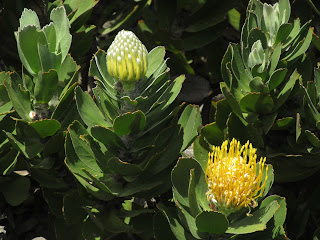







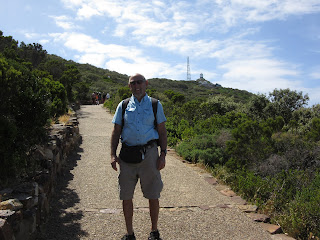




















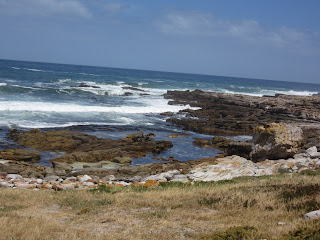



































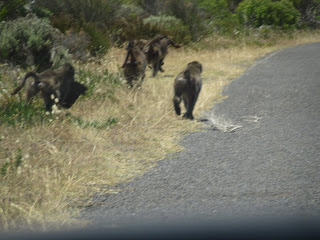




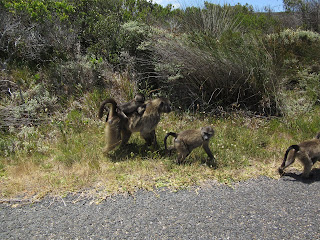
























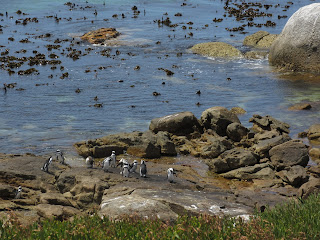

















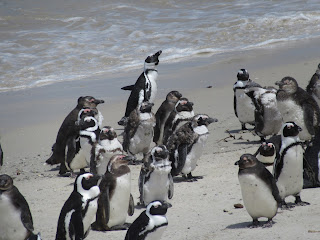














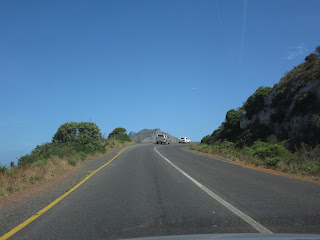























































Looks like a lot of fun you guys! Thanks for sharing Annie! :)
ReplyDeleteThere are African Penguins at the Denver Zoo. We could wait to listen to them someday. I have to spend the day on the Cape like you did. Lil Red
ReplyDeleteThe baboons! Ah!
ReplyDeleteAmazing :)